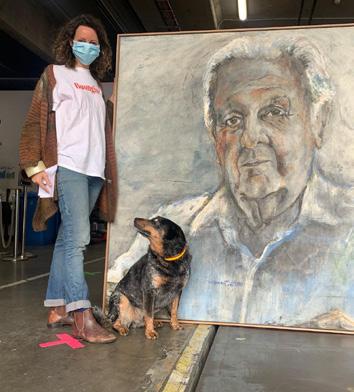
5 minute read
Meet an Artist
Justine Muller is a multidisciplinary artist whose residency on a remote station north of Broken Hill, and a broken down car, led to a life-changing artistic collaboration with Uncle Badger Bates and the Wilcannia community.
An unusual upbringing in The East Sydney Hotel, Woolloomooloo, which her parents owned and ran, has had a lifelong influence on Justine Muller’s identity, artistic practice, and sense of connection to community. The pub saw the likes of CEOs, barristers, actors, journalists and filmmakers rubbing shoulders with musicians, drag queens, folk down on their luck and the underbelly of Woolloomooloo. Justine describes the pub’s frequent visitors as her “extended family”.
Since completing a Bachelor of Fine Arts at the National Art School in Sydney in 2007 Justine’s practice has spanned painting, sculpture, photography and installation, exploring themes of landscape, identity and human nature. In 2020 her portrait of her late godfather Jack Mundey was a finalist in the Archibald Prize.

Artist Justine Muller with her dog Denzel in her studio in Pittwater, Sydney, early 2020.
The incredible sense of loss Justine experienced when The East Sydney Hotel, her childhood home, was sold in 2013, led her to seek isolation and solace in the landscape of far western NSW. Justine took up an artist’s residency at The Ochre House, a remote location of the UNSW-run Fowlers Gap Research Station, more than 100km north of Broken Hill.

Justine Muller, From Bush to Desert, 2018, earth, pigment, ink, charcoal, acrylic, beeswax, oil pastel, oil on hand-pressed cotton, 45.5 x 50cm
In the arid landscape around The Ochre House, Justine painted every day, wrote, read, thought a lot, slept under the stars and cooked on an open fire. When her car broke down the mechanic who fixed it said “you shouldn’t be out here alone” and offered her a Blue Heeler he had rescued a week earlier. “He’ll look after you!” he said. Justine named the dog Denzel, after the mechanic, and he is still by her side years later.
After five weeks at The Ochre House Justine had produced a substantial body of work and began the return journey to Sydney. In the remote community of Wilcannia, Justine ran into car trouble again. While stranded there she met up with Uncle Badger Bates, an established Barkandji artist.
Justine painted Bates’ portrait on recycled Wilcannia tin, and sought his and the community's permission to publish photos of people and places for the work she was doing for Instagram blogger @everydayaustralia. Before leaving Wilcannia, she also took a photograph at the local cemetery in response to her shock and sadness at learning the local life expectancy was 37 years for men and 43 for women. The photo, Town in Mourning, was later a finalist in the 2015 Doug Moran Contemporary Photography Prize.

Justine Muller, Town in Mourning, 2015, digital photograph. Moran Photographic Prize Finalist, 2015 and included in Guardian Australia's list of best and most important photos, 2015.
Uncle Badger Bates and Justine kept in contact and, having seen that she went about things “the right way”, Bates invited her to collaborate on an exhibition exploring the collapse of the BarkaDarling river system. “So that’s what I did for the next three years,” says Justine.
She visited Wilcannia for long periods of time, learning about the degradation of the Barka through colonial mismanagement, producing work on Country where the community could see and be part of the process; “not just Uncle Badger, but the whole community.”
The resulting exhibition, Barka: The Forgotten River, features linocut prints by Bates produced over two decades, sculptures and delicately carved mussel shells. Muller’s own artistic responses include portrait paintings of community members on tin accompanied by audio recordings, photography, video and footprints of over 200 community members in clay from the Barka river bed. Of the collaborative nature of Barka, Justine says:
Of one of her recent artworks, Justine says:
I collected earth, clay and stones that were ground into powder and mixed with binder mediums to create paint. Using large brushes, I wanted to capture my memory of the huge, fast moving and more frequent dust storms that cover the country as a result of mismanagement of the land and worsening climate change.

Justine delivering her portrait of Jack Mundey to the Art Gallery of New South Wales packing room for the 2020 Archibald Finalists exhibition.
In 2020 Justine’s portrait of Green Ban activist Jack Mundey, who was an enormous influence on her life, was a finalist in the Archibald. Jack passed away at the age of 90 in May 2020, of which Justine says:
Justine’s time out on Country and collaborating with the Wilcannia community was life changing: “It informed my art practice and taught me a lot about my country, but when I look back at my art … there was always a little bit of an activist in me.” Justine believes this was a combination of the influence of the pub, her mother’s compassion, her father’s sense of adventure and having Jack Mundey as her godfather;
Justine is currently experimenting with works on paper and using pigments she has collected over her years of road trips. She builds up texture on hand-pressed cotton paper using the pigments, wax and oil paint then box frames them. “I’m thinking I want to push this further and start experimenting with other surfaces and making these works more painterly. I don’t know though! Where do I go after Barka? It was such a huge influence.”
Words: Sarah Crawford
Barka: The Forgotten River will be showing at MRAG from 12 June – 5 September 2021.
A touring exhibition from Broken Hill Regional Art Gallery.
www.saveourdarlingbarka.com
See more of Justine’s work at @justinemullerartist

Uncle Badger Bates and Justine Muller collecting clay from the dry bed of the Barka River around Wilcannia for the installation River of Hope, 2018.










